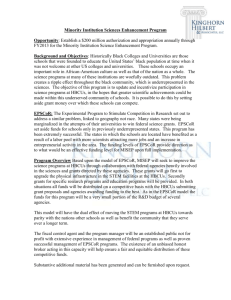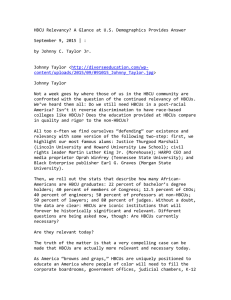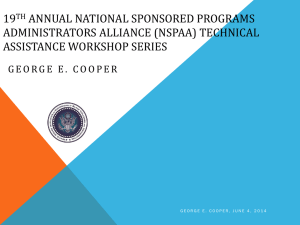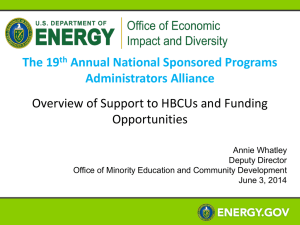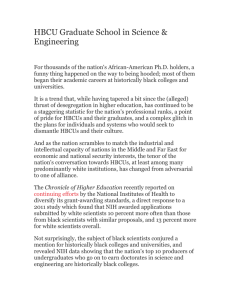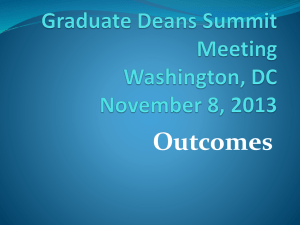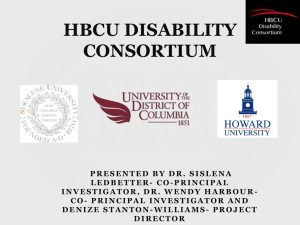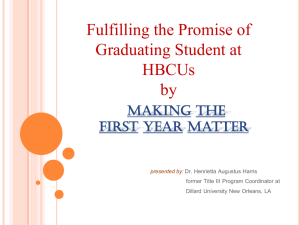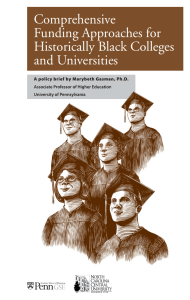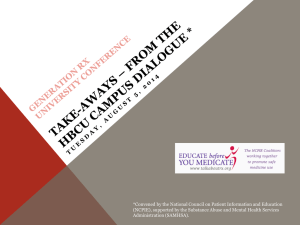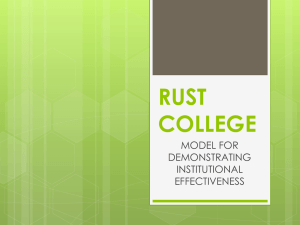Articles, Reports - The Kresge Foundation
advertisement
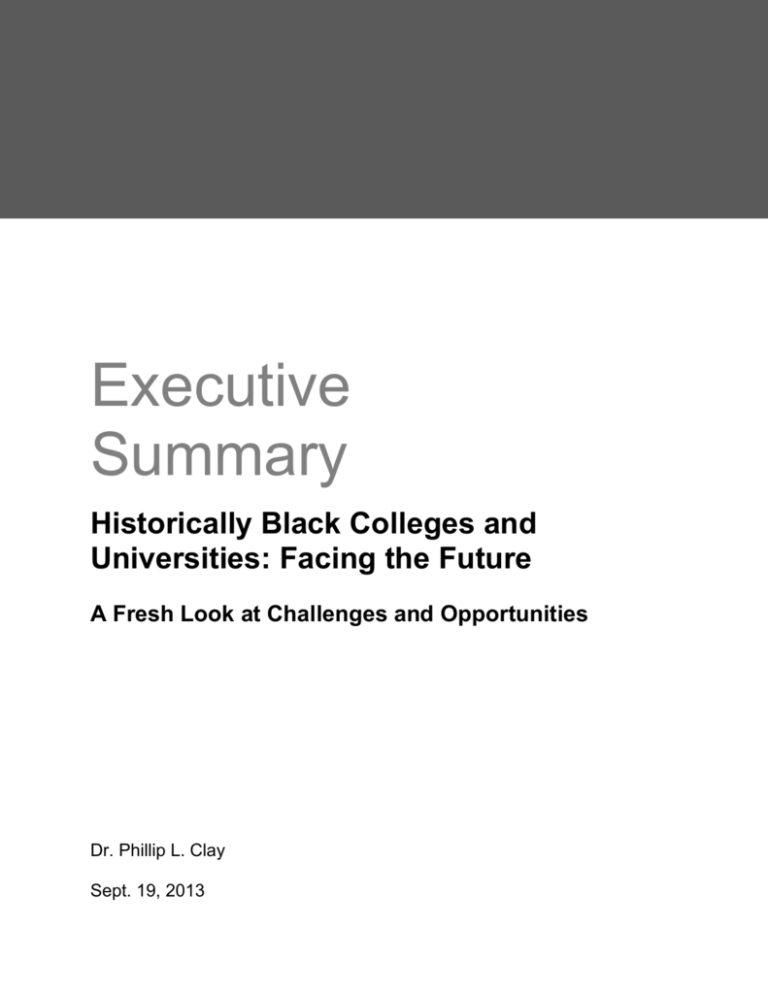
Executive Summary Historically Black Colleges and Universities: Facing the Future A Fresh Look at Challenges and Opportunities Dr. Phillip L. Clay Sept. 19, 2013 1 Historically Black Colleges and Universities (HBCUs) are a set of 105 institutions that have positively transformed the educational opportunities and outcomes for black Americans, and by extension the nation’s professional class. Even though the vast majority of blacks now attend predominately white institutions, the need for HBCUs continues. These institutions as a group continue to provide a significant share of Black STEM professionals, and medical and Ph.D. students. While their contributions are significant, HBCUs face severe challenges. While other small liberal arts colleges also fact challenges, they do so with more resources. If HBCUs are to thrive in the 21st century, Clay calls on them to change institutional practices and transform in ways that make a more compelling proposition. The challenges are serious. For generations HBCUs operated on a stable shoestring. What was a valuable model for black higher education a generation or more ago may be unsustainable today. The shoestring is shorter due to cutbacks, and schools have limited resources to make strategic shifts. As a result, an urgent need exists for these schools to prepare for a future in which their operations are more sustainable as they advance their distinct educational mission that needs to be differentiated and marketed to young people who have many choices. Approaches to transformation There are two possible high-level approaches to transformation. The first is for an HBCU to become more competitive with other institutions in a peer set. For example, a few years ago, Johnson C. Smith University established the goal of becoming competitive with strong HBCUs such as Spelman College or Morehouse College. It has been successfully making changes to attract students and faculty who would not typically consider Johnson C. Smith. The second approach does not assume that competition is necessary for success or that a school has a peer set to aspire to. An approach for weaker, under-resourced HBCUs may be to create a new value proposition. In corporate terms, rather than offer a noncompetitive product in the market, they would offer a new product. Both of these approaches require additional resources. Some can come from reallocation of existing resources and some must come from outside. Colleges and universities increasingly look to new technologies and new models to expand their mission and generate revenue. Online education is one of the most widely anticipated new efforts, but as yet there is no best practice for small colleges that produces gains in education or net revenue, A successful model for online education is likely to come only with collaboration among several schools and an external funder. Framing the process Once a school decides to embrace transformation, the next step is framing the planning process 2 to outline a new vision that among other things will differentiate the school from its past and from other schools, and that has a marketing model for the student it seeks to attract. The central planning challenge becomes what institutional, programmatic or enterprise shifts are required to advance the mission. Such transformation has four broad features: Internal changes and operations, optimally gathering insights and best practices from peer institutions and using experienced consultants familiar with emerging practices and resources to help address conceptual, cultural, financial and operational issues. New program offerings that will meet the growing demand from both students and employers that education be preparation for the world of work that increasingly values both soft skills such as communication as well as professional or technical skills. Institutional changes, in boundaries and scope, ranging from satellite campuses to mergers. Combining institutions and resources might enable a stronger school to better serve an area not well served by several small institutions. Collaborations and partnerships that provide a net benefit to each party – between schools, between a college and a local business or nonprofit or involving colleges that can make some of their assets more available to the community. (For many years, for example, collaboration with the Georgia Institute of Technology has provided students at Morehouse with access to an engineering curriculum that Morehouse could not reasonably implement.) The new environment This transformational challenge will not be pursued in a static environment or in a vacuum. Some dynamic shifts that are occurring or might reasonably be expected in the near future will create the environment in which transformation will take place: Pell grants, a core support for students at HBCUs, are under assault. While grants have been increased somewhat, budget cuts and reduced flexibility are threats. Performance-based funding from state and local governments and foundations increasingly characterizes support for HBCUs and other institutions. Without resources to make changes, it may be difficult to meet new standards. The “consumer focus” has increased in higher education. Institutions will be forced to present themselves to discerning consumers who have many choices. Community colleges and for-profit institutions have gained market share through improved marketing and development of attractive programs and degrees. This is likely to increase while budgets for new programs and marketing decline at HBCUs. As the share of students attending HBCUs declines (presently about 15 percent of black college students attend HBCUs), informal information about them will be less frequently transmitted. Students will be less aware of institutions that are not present in their environment. Population decline in the rural South is another facet of this problem. Financial stability is a growing concern for HBCUs. Accrediting institutions are 3 increasingly strict in enforcing their standards, if not raising them. Efforts to access lines of credit or bond financing will increasingly call attention to the viability of HBCUs as measured, for example, in enrollment patterns and the size of applicant pools. Institutions that fail to make progress in these areas or fall behind will have a harder time accessing resources. Institutions that cannot pay competitive salaries or provide attractive professional opportunities will find it difficult to attract the faculty or staff they need for the future. Deterioration of the physical plant will be an even bigger challenge as HBCUs struggle to find the resources required to maintain and improve their facilities and infrastructure. Embracing the challenge There is a compelling case for a redoubled commitment to HBCUs – one that aims to stimulate and support a transformation of the sector. Their problems and limitations, notwithstanding, they make a disproportionately large contribution to advancing blacks in STEM fields. They help students whose background puts them outside the higher education orbit. Some institutions will embrace the challenge and do well; others will not implement change effectively. A number of HBCUs continue to make strong contributions and are part of a strong peer set in higher education; preservation and enhancement are important for this group to continue in this role. A second group of institutions are also major contributors, but they have one or more handicaps that threaten their viability. With strong leadership, vision and a plan, modest but sustained additional resources can help them transform. Public HBCUs in this group are of special interest because state funds can be the critical lever for them. Finally, there is a group of institutions that face serious challenges, most sharply reflected in accreditation issues but also in enrollment and financial viability. It is important to help them develop a commitment and a plan for transformation, if the evidence and will for such change is to be viewed as credible. The slope for turnaround is steep, but the climb is not impossible if presidential and board leadership is strong, and if alumni and the local community embrace the institution and provide the critical resources. Simply trying harder will not be sufficient these institutions. Colleges and universities have lots of stakeholders. Stakeholders for each school have to assess their own institution and determine whether its stance conforms to what is required to improve the quality and sustainability and then become of part of the change they want to see. If, the stakeholders come together to bring all hands on deck to put HBCUs on a steady path, the 4 core of the sector will be strengthened. But for this to occur, new bridges will have to be built. Foundations and corporations will need to recommit. Alumni will have to show they care. States will have to give more and give more guidance. A new value proposition will to be made to students and their families and to prospective faculty members. A strong president and an engaged board are most critical. New ways of engaging all of the stakeholders will have to be devised. While this is hard work, these tasks are all possible, and the need for transformation has become more urgent. Phillip L. Clay is professor of urban studies and planning at the Massachusetts Institute of Technology, and a former MIT chancellor. He undertook this work while he served as a senior fellow at the Ford Foundation. Clay also serves as a trustee of the University of North Carolina, the Aga Khan University and The Kresge Foundation. Read the report
